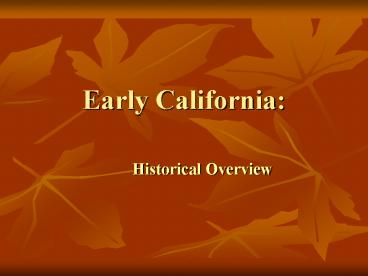Early California: - PowerPoint PPT Presentation
1 / 11
Title:
Early California:
Description:
Before Europeans arrived, the land we call California was inhabited ... Most lived by hunting ... Large game--including deer, antelope, elk, sheep, and bear ... – PowerPoint PPT presentation
Number of Views:56
Avg rating:3.0/5.0
Title: Early California:
1
Early California
- Historical Overview
2
Native American California
Before Europeans arrived, the land we call
California was inhabited by about 300,000 Native
Americans, who lived in tribal groups.
3
Always a Land of Diversity
- California has a greater variety of geographical
regions, landforms, and climates than any area of
comparable size in what is now the United States.
- As a result, an extraordinary cultural diversity
prevailed among the Native American peoples of
California. - Housing, dress, means of transportation varied
from one region to another.
4
What did first Californians eat?
- Most lived by hunting and gathering.
- The staple food throughout much of California was
the acorn, a nutritious food source that has a
higher caloric content than wheat. - Large game--including deer, antelope, elk, sheep,
and bear--were present over more than half of the
state. Fish were abundant in the many streams and
rivers.
5
Europeans first came to California from the
south. Juan Cabrillo and his crew sailed into San
Diego Bay on Sept. 28, 1542.
- Junípero Serra arrived in 1769
- and founded California's first nine missions. He
served as father-president of the missions.
6
Presidios
- Spanish officials established four presidios, or
military forts, along the California coast. - If an Indian revolt or attack occurred at a
mission, the soldiers from one of the nearby
presidios could be rapidly deployed to assist. - Several presidios were located near entrances to
the best ports, at locations where they could
defend the harbors against foreign attack. - Like the missions, the presidios also were placed
in areas where supplies of fresh water were
available.
7
Mexican Era in California
- Mexican independence from Spain was achieved in
1821, following a long, bloody struggle. - The Spanish missions lost their lands.
- For the first time, land was actually granted to
individuals. - A diseño or hand-drawn topographical map was
part of the land grant procedure. - Mexican administrators created huge cattle
ranches or ranchos. A few wealthy land-owning
families emerged as an elite.
8
California Joins U.S.
The Mexican-American War of 1846-1848 broke out
in the wake of the annexation, by the United
States, of the Republic of Texas in 1845. Mexico
considered Texas to be a breakaway province,
whose independence it did not recognize.
Following the war, California was ceded to the
U.S.
9
California GoldRush
News of the discovery of gold in California in
1848 attracted hundreds of thousands of
gold-seekers from across the U.S. and around the
world. Their arrival transformed Californias
economic, social, cultural, and political history.
10
Modern California
How many city names do you see that were derived
from the names of Spanish missions? Where are
these cities located?
11
What natural forces threatened missions?































